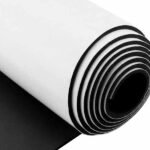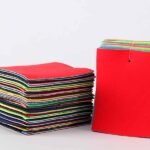Neoprene is a fabric widely used in various industries, but many people may not fully understand its unique properties and applications. Whether you’re looking for water-resistant material or something durable, neoprene stands out. Let’s explore what makes neoprene a preferred choice for many.
Neoprene is a synthetic rubber known for its flexibility, durability, and resistance to water, oil, and heat. This versatile fabric has found applications in sports, fashion, industrial gear, and even medical equipment.
Understanding its strengths and weaknesses can help you decide if neoprene is suitable for your needs. Below, we’ll dive into everything about neoprene fabric and its alternatives.
What Kind of Material Is Neoprene?
Neoprene, also called polychloroprene, is a synthetic rubber developed in the 1930s by DuPont. It is made through the polymerization of chloroprene, giving it unique characteristics that set it apart from natural rubber and other synthetic materials.
Neoprene is prized for its elasticity, insulating properties, and resistance to environmental factors like UV rays and chemicals. These features make it suitable for wet suits, laptop sleeves, and industrial seals.
Key Features of Neoprene:
| Feature | Description |
|---|---|
| Water Resistance | Repels water effectively |
| Durability | Resistant to wear and tear |
| Thermal Insulation | Retains heat efficiently |
| Elasticity | Flexible and stretchy |
| Chemical Resistance | Resists oils, solvents, and ozone |
Its ability to remain stable across a wide temperature range further solidifies its versatility.
What Are the Disadvantages of Neoprene Fabric?
While neoprene is highly functional, it does come with certain drawbacks that might limit its use in specific scenarios.
Neoprene is not biodegradable and can be less breathable than natural fabrics. This can make it unsuitable for long-term environmental sustainability and some clothing applications.
Common Drawbacks:
- Environmental Impact: The production and disposal of neoprene contribute to pollution.
- Weight: Compared to other fabrics, neoprene can be relatively heavy.
- Breathability: It traps heat and moisture, which may cause discomfort in warm climates.
- Cost: It is often more expensive than alternatives like nylon or polyester.
Despite these disadvantages, neoprene’s benefits often outweigh its limitations, especially in specialized applications.
What Fabric Is Similar to Neoprene?
If neoprene doesn’t meet your requirements, you might consider materials that mimic its properties.
Fabrics like spandex, polyurethane, and scuba fabric offer similar flexibility and durability. These alternatives are often used in fashion and industrial settings where neoprene might not be ideal.
Comparing Alternatives:
| Fabric | Similarities to Neoprene | Differences |
|---|---|---|
| Spandex | Stretchy and flexible | Lacks water resistance |
| Scuba Fabric | Durable and structured | Less insulating |
| Polyurethane | Water-resistant | Less elastic |
Each of these options has its own set of advantages and trade-offs, depending on the intended use.
What Makes Neoprene Fabric Water-Resistant and Durable?
Neoprene’s water resistance and durability stem from its closed-cell structure. The material is composed of small, gas-filled pockets that prevent water from penetrating.
This structure also provides thermal insulation, making neoprene ideal for wet suits, gloves, and other water-related applications. Additionally, the fabric’s chemical composition gives it resilience against abrasions and environmental exposure.
Benefits of the Closed-Cell Structure:
- Waterproofing: Prevents water from passing through.
- Heat Retention: Maintains body temperature in cold conditions.
- Shock Absorption: Reduces impact forces, enhancing durability.
These characteristics are why neoprene is a go-to material for outdoor gear and safety equipment.
Which Thicknesses of Neoprene Fabric Are Most Commonly Used?
Neoprene comes in various thicknesses, each serving a specific purpose. Thinner neoprene is often used in fashion and accessories, while thicker variants are reserved for industrial or aquatic applications.
| Thickness | Applications |
|---|---|
| 1-2mm | Fashion, laptop sleeves, lightweight covers |
| 3-5mm | Wet suits, gloves, and sports gear |
| 6mm+ | Industrial seals, heavy-duty protective gear |
Thicker neoprene provides better insulation and durability but may limit flexibility. Choosing the right thickness depends on the balance between functionality and comfort.
How to Choose the Right Neoprene Fabric for Your Needs?
Selecting the right neoprene fabric requires considering its thickness, intended use, and environmental impact.
Key Factors to Consider:
- Purpose: Are you using it for apparel, accessories, or industrial purposes?
- Environmental Conditions: Will it be exposed to water, chemicals, or extreme temperatures?
- Comfort: Thinner neoprene offers more flexibility, while thicker options are more protective.
- Budget: Balance cost against performance for your specific application.
Understanding your priorities will help you make the best decision when choosing neoprene or its alternatives.
Conclusion
Neoprene fabric is a versatile and durable material that excels in water resistance, insulation, and elasticity. While it has certain disadvantages, its advantages make it an invaluable choice for various industries. From wet suits to laptop sleeves, neoprene offers unparalleled performance.
If you’re considering neoprene products, Szoneier specializes in high-quality, customizable neoprene solutions tailored to your needs. With years of experience and advanced production facilities, we deliver excellence in every product. Contact us today to discuss your requirements.











